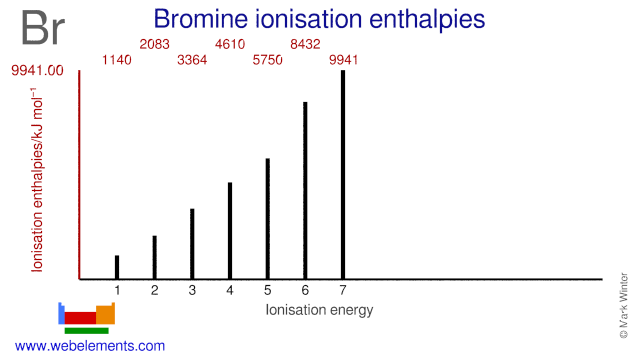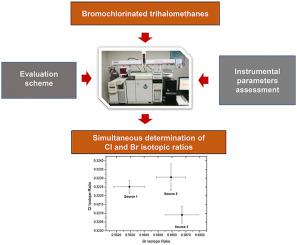79 Br: 81 Br exists naturally in an almost 1:1 ratio, so we observe peaks at 'M' (molecules with an atom of 79 Br) and 'M+2' (molecules an atom of 81 Br) are obtained with relative intensity 1:1 Note that since the relative natural abundances of the isotopes are different, you can tell the difference between the presence of Cl and Br. Bromine is an active ingredient in four products; two products with multiple active ingredients and two products as the sole active ingredient. The multiple active ingredient products control mold, mildew, fungi, insects, and odors in exposed surfaces of bedding, mattresses, textiles, drapes, upholstered furniture, rugs, carpets, and storage areas. Supershift.
Bromine Isotopes Relative Abundance
Bromine (Br) has two stable isotopes and 30 known unstable isotopes, the most stable of which is 77Br with a half-life of 57.036 hours
Standard atomic mass: 79.904(1) u
Table
| nuclide symbol | Z(p) | N(n) | isotopic mass (u) | half-life | decay mode(s)[1][n 1] | daughter isotope(s)[n 2] | nuclear spin | representative isotopic composition (mole fraction) | range of natural variation (mole fraction) |
|---|---|---|---|---|---|---|---|---|---|
| excitation energy | |||||||||
| 66Br | 35 | 31 | p | 65Se | |||||
| 67Br | 35 | 32 | 66.96479(54)# | p | 66Se | 1/2-# | |||
| 68Br | 35 | 33 | 67.95852(38)# | <1.2 µs | p | 67Se | 3+# | ||
| 69Br | 35 | 34 | 68.95011(11)# | <24 ns | p | 68Se | 1/2-# | ||
| 70Br | 35 | 35 | 69.94479(33)# | 79.1(8) ms | β+ | 70Se | 0+# | ||
| 70mBr | 2292.2(8) keV | 2.2(2) s | β+ | 70Se | (9+) | ||||
| IT | 70Br | ||||||||
| 71Br | 35 | 36 | 70.93874(61) | 21.4(6) s | β+ | 71Se | (5/2)- | ||
| 72Br | 35 | 37 | 71.93664(6) | 78.6(24) s | β+ | 72Se | 1+ | ||
| 72mBr | 100.92(3) keV | 10.6(3) s | IT (>99.9%) | 72Br | 1- | ||||
| β+ (<.1%) | 72Se | ||||||||
| 73Br | 35 | 38 | 72.93169(5) | 3.4(2) min | β+ | 73Se | 1/2- | ||
| 74Br | 35 | 39 | 73.929891(16) | 25.4(3) min | β+ | 74Se | (0-) | ||
| 74mBr | 13.58(21) keV | 46(2) min | β+ | 74Se | 4(+#) | ||||
| 75Br | 35 | 40 | 74.925776(15) | 96.7(13) min | β+ | 75Se | 3/2- | ||
| 76Br | 35 | 41 | 75.924541(10) | 16.2(2) h | β+ | 76Se | 1- | ||
| 76mBr | 102.58(3) keV | 1.31(2) s | IT (99.4%) | 76Br | (4)+ | ||||
| β+ (.6%) | 76Se | ||||||||
| 77Br | 35 | 42 | 76.921379(3) | 57.036(6) h | β+ | 77Se | 3/2- | ||
| 77mBr | 105.86(8) keV | 4.28(10) min | IT | 77Br | 9/2+ | ||||
| 78Br | 35 | 43 | 77.921146(4) | 6.46(4) min | β+ (99.99%) | 78Se | 1+ | ||
| β- (.01%) | 78Kr | ||||||||
| 78mBr | 180.82(13) keV | 119.2(10) µs | (4+) | ||||||
| 79Br | 35 | 44 | 78.9183371(22) | Stable | 3/2- | 0.5069(7) | |||
| 79mBr | 207.61(9) keV | 4.86(4) s | IT | 79Br | (9/2+) | ||||
| 80Br | 35 | 45 | 79.9185293(22) | 17.68(2) min | β- (91.7%) | 80Kr | 1+ | ||
| β+ (8.3%) | 80Se | ||||||||
| 80mBr | 85.843(4) keV | 4.4205(8) h | IT | 80Br | 5- | ||||
| 81Br | 35 | 46 | 80.9162906(21) | Stable | 3/2- | 0.4931(7) | |||
| 81mBr | 536.20(9) keV | 34.6(28) µs | 9/2+ | ||||||
| 82Br | 35 | 47 | 81.9168041(21) | 35.282(7) h | β- | 82Kr | 5- | ||
| 82mBr | 45.9492(10) keV | 6.13(5) min | IT | 82Br | 2- | ||||
| β- | 82Kr | ||||||||
| 83Br | 35 | 48 | 82.915180(5) | 2.40(2) h | β- | 83Kr | 3/2- | ||
| 83mBr | 3068.8(6) keV | 700(100) ns | (19/2-) | ||||||
| 84Br | 35 | 49 | 83.916479(16) | 31.80(8) min | β- | 84Kr | 2- | ||
| 84m1Br | 320(10) keV | 6.0(2) min | β- | 84Kr | 6- | ||||
| 84m2Br | 408.2(4) keV | <140 ns | 1+ | ||||||
| 85Br | 35 | 50 | 84.915608(21) | 2.90(6) min | β- | 85Kr | 3/2- | ||
| 86Br | 35 | 51 | 85.918798(12) | 55.1(4) s | β- | 86Kr | (2-) | ||
| 87Br | 35 | 52 | 86.920711(19) | 55.65(13) s | β- (97.48%) | 87Kr | 3/2- | ||
| β-, n (2.52%) | 86Kr | ||||||||
| 88Br | 35 | 53 | 87.92407(4) | 16.29(6) s | β- (93.42%) | 88Kr | (2-) | ||
| β-, n (6.48%) | 87Kr | ||||||||
| 88mBr | 272.7(3) keV | 5.4(7) µs | |||||||
| 89Br | 35 | 54 | 88.92639(6) | 4.40(3) s | β- (86.2%) | 89Kr | (3/2-,5/2-) | ||
| β-, n (13.8%) | 88Kr | ||||||||
| 90Br | 35 | 55 | 89.93063(8) | 1.91(1) s | β- (74.8%) | 90Kr | |||
| β-, n (25.2%) | 89Kr | ||||||||
| 91Br | 35 | 56 | 90.93397(8) | 541(5) ms | β- (80%) | 91Kr | 3/2-# | ||
| β-, n (20%) | 90Kr | ||||||||
| 92Br | 35 | 57 | 91.93926(5) | 0.343(15) s | β- (66.9%) | 92Kr | (2-) | ||
| β-, n (33.1%) | 91Kr | ||||||||
| 93Br | 35 | 58 | 92.94305(32)# | 102(10) ms | β- (89%) | 93Kr | 3/2-# | ||
| β-, n (11%) | 92Kr | ||||||||
| 94Br | 35 | 59 | 93.94868(43)# | 70(20) ms | β- (70%) | 94Kr | |||
| β-, n (30%) | 93Kr | ||||||||
| 95Br | 35 | 60 | 94.95287(54)# | 50# ms [>300 ns] | 3/2-# | ||||
| 96Br | 35 | 61 | 95.95853(75)# | 20# ms [>300 ns] | |||||
| 97Br | 35 | 62 | 96.96280(86)# | 10# ms [>300 ns] | 3/2-# | ||||
- ^Abbreviations:
IT: Isomeric transition - ^Bold for stable isotopes
Notes
- Values marked # are not purely derived from experimental data, but at least partly from systematic trends. Spins with weak assignment arguments are enclosed in parentheses.
- Uncertainties are given in concise form in parentheses after the corresponding last digits. Uncertainty values denote one standard deviation, except isotopic composition and standard atomic mass from IUPAC which use expanded uncertainties.
References
Notation For Isotopes Of Bromine (Br)

- ^http://www.nucleonica.net/unc.aspx


Images For Bromine Isotopes
- Isotope masses from:
- G. Audi, A. H. Wapstra, C. Thibault, J. Blachot and O. Bersillon (2003). 'The NUBASE evaluation of nuclear and decay properties'. Nuclear Physics A729: 3–128. Bibcode2003NuPhA.729..3A. DOI:10.1016/j.nuclphysa.2003.11.001. http://www.nndc.bnl.gov/amdc/nubase/Nubase2003.pdf.
- Isotopic compositions and standard atomic masses from:
- J. R. de Laeter, J. K. Böhlke, P. De Bièvre, H. Hidaka, H. S. Peiser, K. J. R. Rosman and P. D. P. Taylor (2003). 'Atomic weights of the elements. Review 2000 (IUPAC Technical Report)'. Pure and Applied Chemistry75 (6): 683–800. DOI:10.1351/pac200375060683. http://www.iupac.org/publications/pac/75/6/0683/pdf/.
- M. E. Wieser (2006). 'Atomic weights of the elements 2005 (IUPAC Technical Report)'. Pure and Applied Chemistry78 (11): 2051–2066. DOI:10.1351/pac200678112051. http://iupac.org/publications/pac/78/11/2051/pdf/. Lay summary.
- Half-life, spin, and isomer data selected from the following sources. See editing notes on this article's talk page.
- G. Audi, A. H. Wapstra, C. Thibault, J. Blachot and O. Bersillon (2003). 'The NUBASE evaluation of nuclear and decay properties'. Nuclear Physics A729: 3–128. Bibcode2003NuPhA.729..3A. DOI:10.1016/j.nuclphysa.2003.11.001. http://www.nndc.bnl.gov/amdc/nubase/Nubase2003.pdf.
- National Nuclear Data Center. 'NuDat 2.1 database'. Brookhaven National Laboratory. http://www.nndc.bnl.gov/nudat2/. Retrieved September 2005.
- N. E. Holden (2004). 'Table of the Isotopes'. In D. R. Lide. CRC Handbook of Chemistry and Physics (85th ed.). CRC Press. Section 11. ISBN978-0-8493-0485-9.


| Isotopes of selenium | Isotopes of bromine | Isotopes of krypton |
| Index to isotope pages·Table of nuclides | ||

Comments are closed.